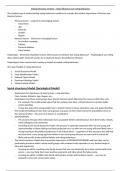Voting behaviour revision – what influences our voting behaviour
The simplest way of understanding voting behaviour would be to consider the relative importance of Primacy and
Recency factors.
- Primacy factors – Long term (unchanging) factors
- Social Class
- Age
- Ethnicity
- Gender
- Region
- Recency factors – Short term (changing) factors
- An election campaign
- Policies
- Electoral debates
- Party leaders
Psephology – the branch of political science that focuses on elections and voting behaviour – Psephologists use voting
data, opinion polls, financial records etc to study the factors that influence elections.
Psephologists have constructed a variety of models to explain voting behaviour
The main Models of voting behaviour
1. Social Structures Model
2. Party Identification Model
3. Rational Choice Model
4. Dominant Ideology Model
5. Voting Context Model
Social structures Model (Sociological Model)
- Emphasises the importance of social groups + characteristics.
- Class, Gender, Ethnicity, Age, Region, etc...
- Emphasises how these social groups have shared interests which influences the ways in which they vote.
- For example, this model would argue that the working class have a shared interest in greater public
sector spending.
- It may also argue that young people have a shared interest in lower education costs and apprenticeships.
- This model of thinking stresses how social groups may pass on their shared concerns and political views to
the next generation – this process is known as socialisation.
- SOCIALISATION:
- The process through which individuals learn acceptable beliefs and behaviours from their family, friends,
work colleagues and community.
- According to the Social Structures Model, this process is especially important when we are young and
impressionable as those feelings and ideas projected on to us when we are young will most likely have a
strong bearing on the political tendencies of our future selves – supporters of this structure also add that
we learn from a very young age from others in our social group because we want to fit in and so we
likely end up with similar political beliefs and voting behaviours.
- The Social structures Model also stresses the importance of INFORMATION BIASES and how they can be
particularly prevalent within certain social groups, with members only exposed to a very limited range of
ideas and arguments:
- Growing up within a working-class family means that you may inherently be in close contact with trade
unions – you may likely hear more positive arguments and ideas about the labour party.
- Growing up within a middle-class family with greater contact with business owners – you may be
exposed to more pro-conservative views.
, Class
Social researchers have historically classified people on the basis of their occupations and, to some extent, their
income – in line with what was previously mentioned class can explain various forms of typical behaviour, including
political attitudes and voting trends.
For decades it seemed that the biggest influence on voting behaviour in the UK was social class – different classes
share similar economic social and cultural characteristics – until the 1970s, class was seen as the most important
factor in explaining voting behaviour.
CLASS ALIGNMENT is the term used by Psephologists to describe this predictable link between class and voting
behaviour – However, we can safely say that especially in recent years the various classes have lost their alignment
to the various political parties
Classification in the UK
An important distinction:
- The social grade is represented by a letter or a letter followed by a number
- The social class is represented by the wording detailed below the social grade E.g., middle class.
- A, B (27%)
- A: Upper Middle Class – Higher managerial roles, administrative or professional (E.g., Chief executive,
senior civil servant, surgeon).
- B: Middle Class – Intermediate managerial roles, administrative or professional (E.g., bank manager,
teacher).
- C1 (28%)
- C1: Lower Middle Class – Supervisory or clerical and junior managerial roles, administrative or
professional (E.g., shop floor supervisor, bank clerk, salesperson).
- C2 (20%)
- C2: Skilled Working Class – Skilled manual workers (E.g., electrician, carpenter).
- D, E (25%)
- D: Working Class – Semi-skilled and unskilled manual workers (E.g., assembly line worker, refuse
collector, messenger).
- E: Non-Working – State pensioners, casual and lowest grade workers, unemployed with state benefits
only (E.g., Casual labourers, pensioners, unemployed e.g., pensioners without private pensions and
anyone living on basic benefits).
This form of classification is useful as it adds greater depth to our understanding of the class system in the UK which
tends to be oversimplified (Upper Middle and Working classes) - there can be significant deviations between each of
these classifications in terms of voting trends that tend to be lost with the traditional classification system.
Some merit can be attributed to this idea of CLASS ALIGNMENT in the sense that in ever since 1974 the conservative
party has received greater support from the A,B,C1 classes than the Labour party – however it is equally clear the
gap between the two parties has significantly reduced since 1974 negating the significance of Class Alignment as a
valid explanation for voting behaviour in the UK.
- Middle class (A,B,C1) support since 1974
- 1974 (OCT) general election
- Conservative party – 56%
- Labour party – 19%
- 2019 general election
- Conservative party – 43%
- Labour party – 33%
We can however negate the significance of CLASS ALIGNMENT as an explanation of voting behaviour by citing the
labour party’s support since 1974
- Labour vote, divided by social class (%)




